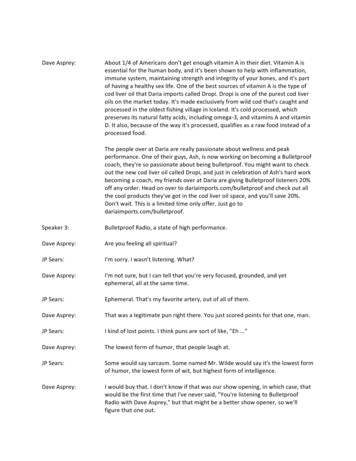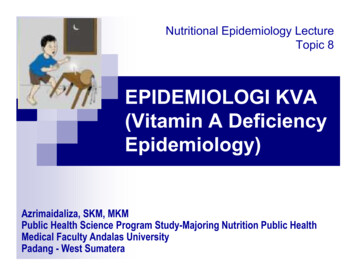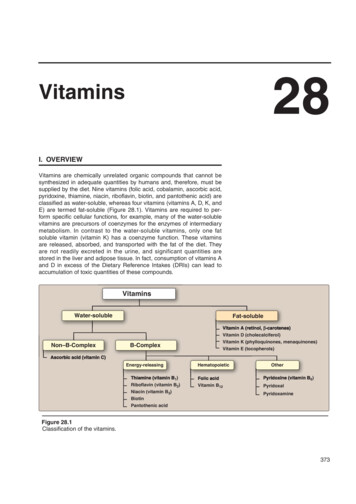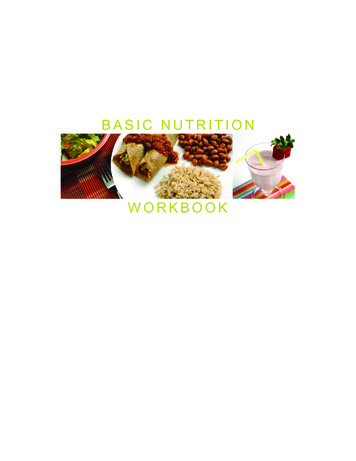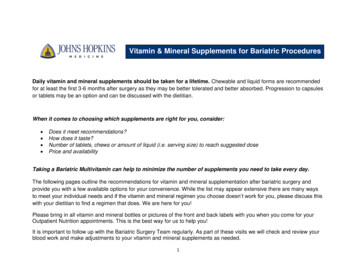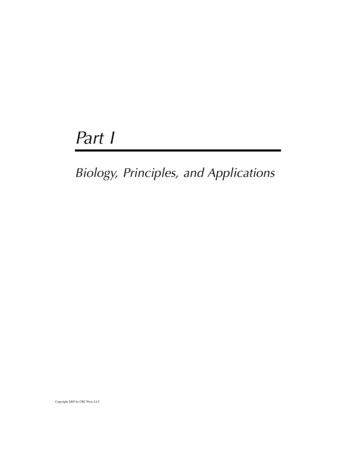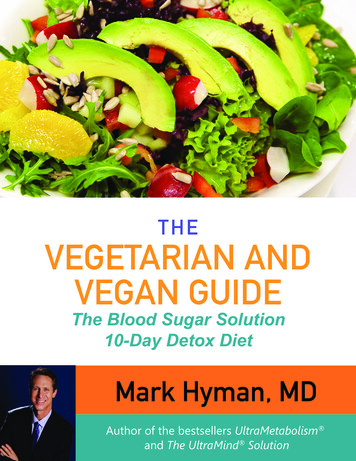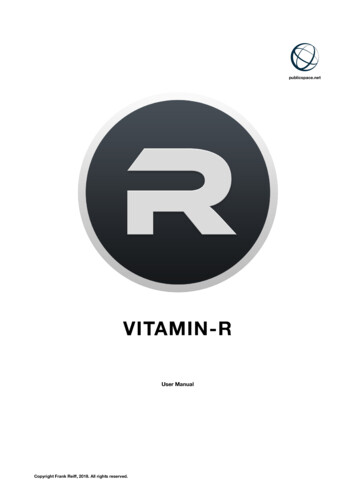
Transcription
publicspace.netVITAMIN-RUser ManualCopyright Frank Reiff, 2018. All rights reserved.
publicspace.netOverviewWhat is Vitamin-R? and what can it do for you?VITAMIN-R is a productivity application that starts where Getting Things Done and similar productivity approaches stop.Most “productivity” applications are really about capturing and organizing your actions. Some of them also give vagueguidelines on what your “next action” should be.Those applications are great and there are some fine examples available on the Mac.Unfortunately, none of these applications help you to actually get anything done. Instead they give you a nice warm feelingthat you’re on top of what you should be doing right now.Unfortunately, most “productivity gurus” end up spending a lot more time reading about how to become more productiveand re-organizing their “system” than actually getting any work done. The work itself is starting to get into the way of itsorganizing. Wait a minute isn’t that the exact wrong way around? . which brings us to the core of the problem.You’d be more productive just getting on with what you know you should be doing right now, rather than readingabout how to do it.While this is certainly true, don’t just run away quite yet. but soon.VITAMIN-R is about really getting things done. To this end, it helps you overcome procrastination, set specific reachablegoals, accomplish them and gain forward momentum ( motivation) for the next iteration.If you are like me, you probably think that you suffer from perennially poor self discipline and spend your days bemoaning thefact that you just can’t do as much as you surely should be able to.Self discipline, however, is not the panacea that one might think. Most of the time our failure to get things done has more todo with a combination of vague objectives (knowing what to do and how to get it done) and the way our brains are wired.Self discipline is the masochist’s way of getting things done and the results are often very poor indeed, because you aregoing against the grain of who and what you are.You can reach true productivity only by creating a “system” that makes it easy to do the right thing every step of the way.VITAMIN-R is our attempt to create just such a system where doing the easy thing is also doing the right thing. Vitamin-Rbeing bits of codes executing on your Mac, rather than ink-on-paper, makes it possible to introduce you to new techniquesand the the (mostly simple) tools that are required to put them to work. This allows you to learn “on the job” where it makesmost sense and has other desirable “side effects”, such as making it easy to log your progress and achievements. This helpsyou understand your own best way of working, as well as helping you value your achievements.VITAMIN-R takes a pragmatic approach to using the insights of various productivity gurus and yes, even scientific researchinto how we are wired. But don’t be afraid, it is not a “system” in the sense of an all-encompassing set of rules that you haveto adhere to rigorously for all your work, all of the time. Rather, you get to discover what works for you and what does not.Once you have figured out what works for you, keep using it and feel free to ignore the rest.User Manual
publicspace.netAs an aside: if you happen to be the paper & pen kind of person (or more likely rollerball & moleskin kind of person), that’sfine too. Feel free to use your pen and paper for taking notes, or even your tomato shaped timer (you know who you are!) ifyou feel like it. I still hope that using VITAMIN-R will provide you with some insights into how you can improve the way thatyou get your work done.This manual is designed to give you a context into which you can place the various techniques built into VITAMIN-R, but the“meat” of the system is embedded in the application itself. This is document is more about giving you the “big picture”, sothat you can understand what the rationale behind specific design choices are.The Logic Behind the MadnessIn the next few sections, we’ll have a look at what the concepts behind VITAMIN-R are.Vague Objectives Cause Us to ProcrastinateIt would seem natural that we should know what we need to do before we can get on with doing it. So why don’t we heedthat advice more often?Everybody recognizes the dread of starting a new task: Authors call it “writer’s block”, the fear of the blank piece of paper.The problem is obvious: you could write or indeed draw anything on that piece of paper. If it was a form to be filled out,you’d fill it out straight away with no hesitation (at least until you get to the bureaucratic jargon that is). The terror comes fromthe fact that we need to narrow down that anything to just one single thing.If we were logical creatures, we’d get straight on with working out what needs to go on that page, but. that is not the waywe are wired. What happens instead is that we put off doing the task and fill our day with some other tasks; often knowingfull well that they are less important and that the blank page is still going to be waiting for us the next day.Neurologically what happens is that our “reptilian brain”, the part of our brain that is responsible for keeping us out of harm’sway, triggers the alarm as soon as it detects the uncertainty. Imagine a security guard looking at a wall of screens. Hedoesn’t know what the screens really show, but his job is simply to push the big read alarm button as soon as he sees“something suspicious”. This big red button is the “Fight-or-Flight-Response” and it can as easily be triggered by a blankpiece of paper as by a saber tooth tiger.The adrenal medulla produces a hormonal cascade and our IQ plunges because this is obviously no time for the clever guyworking in the neocortex to philosophize about the meaning of life. We are left with a binary two choices: fight or fly.Clubbing the page to death (though tempting) is unlikely to work, so we start running. Not literally, but by directing ourattention to something else. probably doing our weekly action point review to (evidently falsely) re-assure ourselves that weare still in control.Unreachable Objectives Lead to FailureHow often have we been asked to “think big” and set our sights high? It shows ambition, it’s the Can Do attitude. Besides, ifyou set your sights too low, you’re never likely to get anywhere, right?Well actually no. Setting unreachable, unrealistic goals will lead you to fail miserably. Every time. Guaranteed. That will makeyou miserable and no matter how good you get, you’ll never be quite good enough. This is an interesting and time testedway of bringing up the next generation, but it is not the way of getting anything done. Besides, if you find yourself in thedreaded situation of having achieved your innermost goals, effortlessly and too early in life. you can always keep climbingand be happy every step of the way.Small Successes Keep Us MotivatedMore importantly, unreachable objectives are usually not very useful for getting started. They tend to be very vague, so theyare effectively un-actionable.One of the most useful lessons of David Allen’s GTD is to insist on specifying the next action that needs to be taken.User Manual
publicspace.netMoreover, another platitude “success breeds success” comes into play here. Once we have achieved our first, now bydefinition reachable goal, we feel more motivated and less stressed about reaching our next goal.Ideally our every working day would consist of a chain of mini-successes, leaving us energized and fully in control of ourprofessional destiny, rather than making us go home dejected and stressed out.Attention v. TimeTime is the great equalizer. We all have the same amount of time in every day, but is it really our time that is limited or is it ourattention?Time is comparatively easy to come by. Some people believe that they can work 14 hour days with full concentration andthat any one hour chunk of that time is as good as any other, but once we put down the work-yourself-to-an-early-deathbusiness book and have a cocoa, most of us suspect that this isn’t really the case. Not that we would dare say so aloud lestsomebody else, who clearly can work those 14 hour days, were to overhear us.Especially in creative endeavors, we simply can’t juggle more than a certain number of things at the same time and wecertainly do not have 18 hours of attention to expend every day. It’s a bit like “spending time with your kids” versus “givingyour kids the attention they deserve”. You can sit with your kids in front of the box for hours, but what they really need issome “quality time” with their parents.Our various “projects” need our attention more than they need our time and attention doesn’t necessarily come inexchangeable 60 minute blocks.Some people work better in the morning, some better in the evening. Monday may be a better day for goal setting thanThursday. Simply re-scheduling tasks so that you can do them at the times of the day, or indeed the day of the week thatworks best for you can give you a significant productivity boost.Single Tasking v. Multi-TaskingMulti-tasking has been quite the buzz word for a long time. Reams of productivity literature have advocated using every lastbit of spare processing power to reach new heights of productivity. Doing your taxes while on the phone, running on yourtreadmill and keeping half an eye on your stock market ticker has been advocated as the height of “manager nirvana” formany years.Unfortunately, we are really, really, really bad at multi-tasking. Doubly so if we happen to be carrying around a “maledifferentiated” brain. The clever scientists looking into how our brains work have long known that we only have around 6-8“chunks” available in our working memory: adding a new chunk will simply push out an existing one.Can we really be that stupid? But we went to the moon! The answer seems to be a resounding “YES” written in mile-highletters. We can’t multi-task. At best, we can do two or more things with half or less of a brain, at worst we’d be better offhaving done neither of the tasks because our error rates sky rocket when we are going against the grain of our abilities.Note that this applies mostly to logical thought (L-mode or “left” brain stuff) and not so much to more internalized skills. Formost people, for instance it’s okay to walk and talk at the same time, but when you observe a toddler who is learning towalk, you can clearly see that at that age both activities are still using the same hardware.Distractions & InterruptionsAll this brings us to another productivity killer: distractions.Our “working memory” is where we do our logical reasoning and filling those 6-8 slots with useful chunks is very muchharder than emptying them. All it takes to empty the slots is a ringing phone, but once you want to refill them with the usefulchunks, you need to rely on your long term memory. and the less said about the speed and accuracy of this, the better.In practice, this means that as soon as your attention wanders, your “working stack” is dumped and it can take up to half anhour to get it back up to operating temperature. Even then you run the risk that some things have just vanished forever.User Manual
publicspace.netA phone call thus does not just cost you the five minutes it takes to field it, but it might wreck your entire work session.This is why it’s so crucial to limit distractions to an absolute minimum at least for as long as you are actively working onsomething that requires mostly logical thought.When viewed in this light, the current craze for tweeting, messaging, emailing, etc. is tantamount to productivity suicide.High distraction work settings such as open plan offices, while being nicely social, are also concentration killers.The Exocortex: Your brain outside of your brainNo, the exocortex is not located somewhere in your skull, or your body for that matter.It’s a geeky word to describe the external tools and systems that we can use to patch the holes in our “wetware”.Pen and paper dramatically improve your performance in an IQ test. It’s a great place to keep those chunks that keepdropping out of your working memory. The chunks are no longer in your working memory, but the “breadcrumbs” left on thepiece of paper can “jog” your brain into retrieving them more quickly.A small example: Try dividing 156 by 13 in your head. You probably can’t do it. Now try the same thing on a piece of paper.Assuming that you were paying attention in primary school, long division shouldn’t be a problem. Now try doing it on acalculator. See what I mean?R-Mode & L-ModeWe’ve all heard of the two sides of the brain: the “left” and the “right” hemispheres.The “left” hemisphere has long been the star of the show. It houses language, numbers and logical thought and it proceedsin a linear sequence. The “right” hemisphere is a bit messier and gets a lot of bad press as a result. It processes informationin a visual and intuitive manner and can come back with a deep insight immediately, never or any time in between.Since the division into two “sides” isn’t really all that strong, the terms L-mode (linear) and R-mode (rich) are more useful.L-mode is great because it can be relied upon to mostly work properly and come back with results in a nicely predictablemanner. Once you’ve worked something out in L-mode, you know exactly how you came to your result. The R-mode on theother hand can be a bit of a capricious diva. You ask it a question and if you are lucky, you get a deep insight straight away.Only you don’t know why so you need to get the L-mode working overtime just find out how to justify what you alreadyknow. If you are not so lucky, nothing at all happens. Often for a very long time. You might wake up in the middle of the nightwith the right answer (that’s how the three dimensional structure of DNA was worked out), or you might get into the bath,have a brain spark and then run naked through the streets of Athens shouting “Eureka” (that’s how Archimedes worked outthe previously intractable problem of how to calculate the volume of irregular objects). Then again your R-mode might nevercome back with anything useful at all.In most situations both modes work together. Experts rely much more heavily on R-mode than beginners who focus almostexclusively on the L-mode. Learning typically involves a flow from L-mode to R-mode. Experts don’t work out problemsmore quickly by going through the same steps as beginners. They skip the steps by having better intuition about what needsto be done, then work backwards to find a logical justification for their snap judgement (and are often right into the bargain).Time SlicesThis is a key building block of the VITAMIN-R approach to helping you get things done.Time Slice is our term for describing a “chunk of time”. This is variously called a “time box”, a “sprint” or a “pomodoro”, butwe prefer to use the connotation-free “time slice”.In a way, it’s a misnomer. It should really be called “Attention Slice” but attention is hard to measure and time isn’t.In order to become more productive, we first need to accept that our attention is limited and that allocating more of it thanwe have, is not going to do us any good. Integral to our approach is that we accept that we can only really concentrate onUser Manual
publicspace.netone thing at a time and for a relatively short amount of time at that. Very few people can really concentrate for an entire hour.The best racing drivers can do so for up to two hours, but not every day, and not more than once in any 24 hour period.Our time slices are thus short. They don’t all necessarily have the same length, but they very rarely go beyond the 45 minutelimit. More typically, we’d recommend something between 15 and 25 minutes.A time slice is thus a chunk of time in which we are working towards a well-defined specific goal that is easily reachablewithin that time frame.The Importance of Guilt-Free BreaksAfter concentrating for 45 minutes, we need to switch gears, so taking guilt-free breaks is an integral part of the Vitamin-Rsystem.Taking a break doesn’t necessarily mean that we need to stop working. We just don’t work with total focus. Ideally, we getup and leave our computer and do something different: perhaps return that call that we ignored during the time slice, checkour mail, tweet if we can’t help it. or go off to the coffee corner or out for lunch.Getting up and away from your computer also has obvious health benefits. Sitting cramped up in front of your computerscreen merely tapping away at a keyboard for hours on end causes all kinds of health problems, ranging from run-of-the-milltension headaches, blurred vision, aching backs, tense necks and sore shoulders to serious repetitive strain injuries (RSI) andCumulative Trauma Disorders (CTD), such carpal tunnel syndrome, etc.It is also a good idea at this stage to remember that that we can think in two modes, the “linear” L-mode and thetemperamental “rich” R-mode. During the time slices, the time pressure and attentive focus put the L-mode firmly into thedriving seat. The R-mode is still active, but works at a reduced pace because it shares some of its resources with the Lmode which is in overdrive mode.The R-Mode has received some poor press because we are much more comfortable associating “logic” and “analysis” withintelligence rather than crediting vague and unreliable attributes such as “intuition” or “creativity”. That’s a shame becausethe R-mode is, in addition to all the mushy emotional stuff, also responsible for things such as pattern recognition, syntheticlearning and non-verbal and visual problem solving. Paradoxically this is precisely how we become experts. It’s how we just“know” something straight away but can’t quite put it into words (hint: R-Mode doesn’t do language).We first learn something and do it as “beginners” using mostly L-mode. Once we become really good at it (that’s the goal),we don’t need to think about it anymore. An experienced car mechanic doesn’t need to work out that your clutch is burnedout from first principle. By the time you have finished your first sentence (I’m not sure.), he’s recognized the pattern andalready knows that “it’s going to cost you”. What comes after that is using the L-mode to double check the assumption andcome up with a proper explanation (working out why he knew straight away without looking).Keeping our brain busy with L-mode tasks for long periods thus does not only burn out the L-mode, but it blind-sides us tothings that would otherwise be obvious to us.Of course, these are all gross oversimplifications. Both modes almost always work together, but most of the time one ofthem is dominant.Every hobby programmer recognizes this scenario: you just start writing a few lines and suddenly you are “in the zone”. Fivehours later you have written an amazing amount of code and you slip into bed (this picture isn’t complete without the sunalready rising outside) in the knowledge of a job well done. The next day, you wake up tired. and with the realization that youcould have done a better job in just 5 minutes. strategic thinking is one of the things that L-mode suppresses.Taking regular breaks allows our R-mode to catch up with what we’ve been busy doing and provides it with an opportunityto process, pattern match, associate and synthesize the experience. At the end of the break we can see more clearly how toproceed, and perhaps what needs a little more work or needs to re-done (hopefully better) from scratch.User Manual
publicspace.netTaking a break is thus nothing like “being idle”. It allows us to re-charge our batteries, process what we’ve done and planwhat we need to do next. Feeling guilty about taking breaks, is counterproductive as it reduces the effectiveness of ourrecovery and prevents us from letting go of the narrow L-mode focus and thus impedes our ability to thinking strategically.We will now explore three different techniques for getting the best out of breaks: timed breaks, priming andbreadcrumbs.Timed BreaksSo we’ve seen that taking regular breaks is essential to being productive, but there is one caveat: you need to get back towork at some stage and as tempting as spending an entire day letting your R-mode get on with things might be, it won’t getthe job done.Getting back to work after a break isn’t just a matter of restoring your “working stack” from backup. There is also the smallmatter of overcoming your resistance to starting again. Of course, if your motivation is already high because your last timeslice was a big hit that won’t be much of problem.On the other hand, open-ended breaks do lend themselves to endless procrastination and instead of having to overcomeyour resistance to get started once or twice a day, using short time slices in the manner suggested might mean having toovercome this resistance every half hour!Something that really helps keep things moving smoothly and with little resistance are timed breaks.If you decide up front that you will have a 20 minute break and you use some external means to keep track of that time, bethat a wind-up timer or a superbly neat Macintosh application (hint), you can enjoy a truly guilt-free break and find it mucheasier to get going again as soon as the time has elapsed. In this way, you never really tell yourself “I’ve stopped workingnow” and you thus don’t have to overcome the initial procrastination hurdle for each iteration of the process.The Priming TechniqueWe have already discussed the beneficial effects of taking regular guilt-free breaks on our R-mode’s performance. We cantake this a step further and instead of just letting our R-mode get on with it, we can plan what we want it to work on whilewe are enjoying our break.In particular, when we stop in the middle of a task, it is worth taking a few moments to fast forward and predict what thenext stumbling block for that task might be. Most intellectually challenging and creative tasks require us to take difficultdecisions based on incomplete information or make seemingly arbitrary choices between largely equivalent alternatives.If one of those choices or decisions is waiting for us when we come back from lunch, the first thing that will happen is thatwe just will not know how to continue and all progress on the task will effectively be blocked until we make that choice.Worse yet, if we just flip a coin to get going again, chances are that we’ve taken the wrong decision and may never realize.If we can anticipate such road blocks before we take our break, we can “prime" our R-mode to work on this decision orchoice while we go for lunch. Sometimes we will obviously draw a blank and still be blocked by the problem when we getback, but frequently we will get that priceless insight “for free”.Priming itself is very easy. We just need to identify the problem and think about it for a few seconds. Just think "I'll need tohave a decision on this by the time I come back".If you want to, you can try to provide your brain with a bit of sensory input to make sure it gets the message. You can type orbetter yet handwrite or speak the question out loud.We obviously don't have to wait until just before the break before we determine what the next road block is going to be. TheNow & Later Board provides us with a convenient place to jot down any stray thoughts while they go through our heads andreviewing the "later" pad before we take our break is a best practice.User Manual
publicspace.netLeaving BreadcrumbsIn the world of productivity literature, Hänsel and Gretel and the Brothers Grimm are often overlooked and while using the“breadcrumbs” technique ultimately did not work for them (those pesky birds ruin things for everyone), we can all learn avaluable lesson from them:"Just wait, Gretel, until the moon rises, and then we shall see the crumbs of bread which I have strewn about, they will showus our way home again."We can apply the same technique to mitigating the inevitable downside of having a break: you dump your working memoryand will have to painfully rebuild it before you can become productive again. Instead of letting it evaporate into thin air, simplydump your “working stack” on a piece of paper or into a text editor. You don’t need to write a novel; a few well chosenwords can jog your memory and make it much easier to restore your working memory from its backup.How Vitamin-R Puts All This To WorkIn this section we’ll see how Vitamin-R puts all these ideas together to create a smooth flow of work.WorkflowIn its simplest form, the Vitamin-R workflow works looks this:Define TimeSliceWork onTime SliceRecord &AssessTimed orInformalBreak!First, you define a time slice (the combination of an objective and a time frame), then you work for that amount of time onyour objective. You then record and assess how you did (to allow you to become more aware of what works for you andkeep you motivated by recording your successes) and have an at-your-desk or an away-from-your desk break. Then youstart all over again.Of course, Vitamin-R assists you throughout this process.In the first stage, Vitamin-R walks you through the process of defining a time slice with a clear, specific and easily reachableobjective and appropriate time frame.While you are working on the time slice, Vitamin-R keeps time for you and helps you stay focused by reminding you of yourobjectives and the time pressure that you are under. The Vitamin-R logo in the menu bar displays the remaining time andoptionally can periodically play ticking clock sounds or use speech synthesis to inform you of the time passing. The spokentext is fully customizable and can inform you on how much time has already elapsed, how much time is left or re-state yourobjective to knock you out of your day dreaming.Once your time slice has elapsed, Vitamin-R will ask you to (very briefly) rate your attention level and if you have notmanaged to complete the time slice it guides you through the process of assessing whether you should continueimmediately or take a break first. It will automatically record the details of your time slice and your rating of it to allow you togain more awareness of our work habits.User Manual
publicspace.netYou are then sent either on a timed or an open-ended break. At the end of the timed break, you’ll return automatically to the“define time slice” stage. In an open-ended break, it’s up to you to go to Vitamin-R and start a new iteration.The Now, Later & Scratch PadsIn addition to the pure workflow and recording aspects of the tool, Vitamin-R also offers you the services of its note padswhich acts as a notepad that you can use to keep track of the resources you need to achieve your current objective, jotdown notes to dump your working memory, remember things for later and getting them out of your mind without having toworry about forgetting them, plan your current activity, keep snippets, etc.While the note pads offer a full-featured rich text format (RTF) editor with niceties such as spell checking, different fonts andcolors, drag & drop support, external links, picture embedding and much else besides, they are meant as a working memorynote pads, not a word processor. To that end they have a number of additional features that should make it easier to usethem in that manner.There are three pads: the Now Pad, the Later Pad and the Scratch Pad. The Now Pad is for dumping your working memoryto make it easier to get back to where you were should you get interrupted or run out of “chunks”. The Later Pad is foreverything that goes through your head but isn’t needed right now. You won’t be able to get it out of your head until youwrite it down somewhere because you’ll be worrying about forgetting it. So put it in the Later Pad and then feel free to forgetall about it. The Scratch Pad is a free form note taking tool for everything that does not fit neatly into the other categories.Note pads are all very good but what should you put in them? Vitamin-R offers a number of ready made templates that getinserted at the beginning of the relevant sections and walk you through the questions to ask and the things to write down.Finally, the FastType feature allows you to create action items, bulleted lists and checklists with a minimum of fuss byautomatically translating certain characters into those formats. Try typing “ Ring your brother” into the Now & Later Boardand see what happens!First ContactEnough theory already. Let’s go through an example of how to use Vitamin-R in practice.Let’s say that I have to write some documentation for my latest application. What the heck, let’s call it “Vitamin-C”. I’mdreading this because what kind of documentation should I write? what style should I write it in? do I start with ascreencast? or with the user manual? the help book? In other words, I’m feeling a bit overwhelmed here and the temptationto procrastinate is definitely there. so let’s use Vitamin-R.The application is already running, so I go to the right side of the menu bar and click on the (R) icon:!User Manual
publicspace.netI’m greeted by the Vitamin-R window with the Help Pad open on the right. The Help Pad is a great place to learn aboutVitamin-R and the productivity techniques it embeds. Many features have a ? button that leads to the relevant Help section.For now though, a quick click on the ? icon in the window title bar collapses the Help Book to give me a more streamlinedinterface.The colorful icons to the right of the Vitamin-R logo in the window title bar open and close the pads that expand to the rightof the window. They are in order: the Now Pad, the Later Pad, the Scratch Pad, the Log Book, the Statistics Pad and theHelp Pad.On second thought, I don’t want my calendar events to interrupt me either, so I click on the little !icon next to the“Duration:” title and select “Hide Calendar Events”.After that little bit of custo
Self discipline is the masochist’s way of getting things done and the results are often very poor indeed, because you are going against the grain of who and what you are. You can reach true prod
